In the latest episode of #NWConnect, we chat to artist Seeun Kim, whose exhibition The Oxford Project can be seen at The North Wall from 28 May – 12 June 2021.
Using jewellery and metal objects, the OXFORD PROJECT seeks to examine some of the diverse social issues in today’s society, in particular, how partially-sighted people, or those who are hard of hearing communicate, and how we may gain greater respect for other forms of communication.
Podcast Transcript
Download #NWConnect Seeun Kim Podcast Transcript
Kim 0:00
Hello, and welcome to North Wall Connect
Amelia: A new podcast series where we talk to the talented artists featured here at the North Wall Arts Centre.
Kim: brought to you by your hosts Kim
Amelia: and Amelia.
Kim Glassman: 0:11
Today we are speaking with Seeun Kim about the OXFORD PROJECT, which will be showing at The North Wall from the 28th May until 12th June 2021. Born in South Korea, Seeun Kim trained in traditional Japanese handicraft, and precious metals at Tokyo’s Hiko Mizuno’s College of Jewelry. Seeun, by then an accomplished jewelry and metal craftsman, came to the U.K in 2016. Having spent time in Oxford learning English, Seeun completed an MA at the Royal College of Art, the OXFORD PROJECT is the result of her time there. Using jewellery and metal objects, the OXFORD PROJECT seeks to examine some of the diverse social issues in today’s society. In particular, how partially sighted people or those who are hard of hearing communicate. And how we may gain greater respect for other forms of communication. Seeun’s latest project Assemblage was made during lockdown to remind people that, despite language and cultural barriers, we are all part of the same global puzzle. Seeun will also be exhibiting her Silla Collection – ‘Hanji’ Brooch Series: 100 handmade stone brooches inspired by ornaments of the Silla dynasty and her Heritage Collection: 100 handmade ornaments inspired by Victorian Era jewellery. We are so excited to have Seeun join us today and to explore the inspirations for her work, so welcome Seeun.
Kim Glassman: 1:20
How are you doing today?
Seeun Kim: 1:22
Good
Kim Glassman: 1:23
Why did you choose to study jewellery and metalcraft in South Korea; did you grow up in a creative environment?
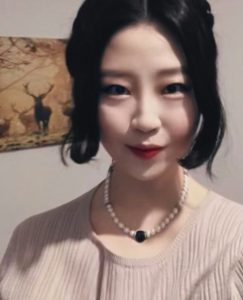 Seeun Kim 1:30
Seeun Kim 1:30
I think the reason I became interested in jewellery and metalcrafts was because of my upbringing in South Korea. My mum was very interested in various education fields for me and always endeavoured to nurture my creativity – so I was taught the piano and art from the age of five. I still remember feeling so happy when I enjoyed craft time in kindergarten. It was the happiest moment of my childhood; to create something new by hand and it made me satisfied and confident. Furthermore, when I was a child, my grandparents enjoyed travelling and my grandmother always gave me gorgeous hair ornaments and jewellery as souvenirs. So, I have been interested in jewellery since childhood and these memories helped me in my decision to study jewellery and metalcrafts.
Kim Glassman 2:20
Wow, so it’s really been since you were very young. What brought you to the UK and why did you choose to show in Oxford?
Seeun Kim 2:29
I really love travelling to other countries and have enjoyed travelling to the UK and Europe during my Spring breaks. I think my extrovert personality resembles that of my grandparents. My grandparents enjoyed travelling with their business to various countries, including the UK, the US and Europe, since they were young. The UK was my grandparents’ favourite country.
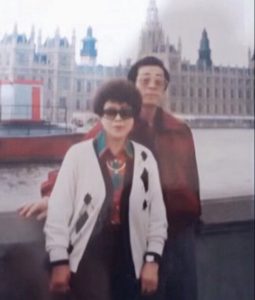 When I was young, my grandfather often told me that the UK is a very advanced Western country and that we can learn many things from its culture. Furthermore, my grandmother was very interested in Western arts. She told me that the British Museum is the most valuable and educational museum in the world. Since the 1960s, my grandparents visited both Oxford and Cambridge for business reasons. To recall my grandfather’s words, he told me about Oxford before entering primary school. “Oxford is a gathering city of prestigious colleges with talented students. So, you have to study hard and be a talented person like Oxford people.”
When I was young, my grandfather often told me that the UK is a very advanced Western country and that we can learn many things from its culture. Furthermore, my grandmother was very interested in Western arts. She told me that the British Museum is the most valuable and educational museum in the world. Since the 1960s, my grandparents visited both Oxford and Cambridge for business reasons. To recall my grandfather’s words, he told me about Oxford before entering primary school. “Oxford is a gathering city of prestigious colleges with talented students. So, you have to study hard and be a talented person like Oxford people.”
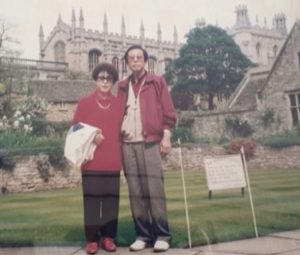 My grandparents always encouraged me to be a talented person like them. I think that, compared to my cousins, I grew up being favoured by my grandparents perhaps because I am like them in both appearance and personality. I was the apple of my grandparents’ eyes! I am so proud of them and I have great respect for them. I decided to study English in Oxford as Oxford is my grandparents’ favourite city.
My grandparents always encouraged me to be a talented person like them. I think that, compared to my cousins, I grew up being favoured by my grandparents perhaps because I am like them in both appearance and personality. I was the apple of my grandparents’ eyes! I am so proud of them and I have great respect for them. I decided to study English in Oxford as Oxford is my grandparents’ favourite city.
Kim Glassman 4.04
That’s such a lovely story, listening back to how your Grandparents thought about Oxford and Cambridge. So you came here to learn English but then you completed a Jewellery and Metal Masters at the Royal College of Art in London. Why did you choose to exhibit your degree show work and your latest pieces at The North Wall Arts Centre in Oxford?
Seeun Kim 4:28
Oxford and London are very special cities for me. These two cities have been part of my work and my UK life. When I needed inspiration for my work, I often visited the collection at the Ashmolean Museum for inspiration. I became nostalgic about my time learning English in Oxford. So, when I missed my family and country in London, I would sometimes go to Oxford and it would help me overcome all the difficulties just by visiting the city. If London is the city of my studies, Oxford is where my heart is and it’s for this reason that I decided to stage an exhibition this May at The North Wall.
Kim Glassman 5:09
Aw that’s a beautiful way of saying it. Thinking about your work for your degree show last year – Why was the focus of the work on social inclusivity?
Seeun Kim 5:23
I think it is important to balance two factors – the cultivation of a critical mindset and the maintenance of a respectful mindset. I am interested in diverse global fields – arts, history, culture, humanity, science and society. Part of my mum’s ambitious programme for me was to hire a teacher before starting primary school. With this teacher I learnt Korean orthography and how to read the newspaper. As a result, I learnt the art of 1-1 discussion with a teacher through sticking my favourite newspaper article in my notebook for discussion every day and I did this until I graduated from secondary school. I think this awareness of the world through the media gave me an understanding of diverse social issues and helped me broaden my horizons widely. Also, over the last year during the pandemic, there have been so many global social issues. I was even more aware of these issues and I felt that the love of humanity in our society was going to collapse. I have always thought that more teaching of humanity is so important in today’s society and this is why I focussed my degree on social issues. As an alumnus of the Royal College of Art, I must continue to be aware of social inclusivity – the RCA’s motto is after all – Noblesse Oblige – meaning that if we are privileged we must be responsible.
Kim Glassman 6:55
Those are very, very wise words. Did you feel, living in the UK for the last four years, that you also experienced language and cultural barriers and did that inform the work you did for your degree show?
Seeun Kim 7:12
Sure. After graduation in Japan, I started from zero in Oxford. There are various cultures and languages in the world and people have such different perspectives internationally. I think no one can learn a foreign language perfectly straight away. I have spoken Japanese and Korean all my life so speaking English was not easy for me. However, I endeavoured to break the language barrier and I committed myself to absorbing as much English culture as possible while in Oxford. Luckily, most Oxford people including my brilliant neighbours, friends and acquaintances helped me to adapt to English life while studying in Oxford. I think my time in Oxford was such a meaningful part of my life. I know I belong to the younger generation who live for tangible things and value materialism in our society. However, my time in Oxford was very meaningful – it was a time for me to look into the essence of life and place more value on the intangible aspects. It made me more interested in cultural and social diversity and led to the completion of the ‘Braille Object Project’ and ‘Sign Language Object Project’ for my Royal College of Art degree show in 2020.
Kim Glassman 8:32
Wow, I mean there are many beautiful pieces of jewellery that make your Silla Collection – you made them for your degree show and they certainly highlight your tremendous skill and experience in metal craft. What captivated you about the Silla dynasty and their gold jewellery?
Seeun Kim 8:51
The Silla Collection 100 Project consists of 100 brooch pieces and was inspired by the traditional ornaments of the Silla dynasty. In the Three Kingdom period of Korea, the development of ornaments was subdivided and we can learn about its extensive history of metal crafts. The Silla period is said to be the golden age of the development of Korean ornaments. Silla is the country in which the most brilliant metal culture flourished and the metalwork was famous for its range, quantity and quality. In the Silla period, science and technology were also highly developed, and metal processing techniques such as metallurgy, gold, copper working and plating were very advanced. In addition, Silla’s special ceramics and lacquers were exported to China and Japan. The historical and cultural backgrounds of Silla so impressed me that I was inspired to create the Silla Collection 100 Project.
Kim Glassman 9:56
And I know you have made a new collection of Silla jewellery, to be seen at The North Wall for the first time. You mentioned that you have used ‘Hanji’ a traditional Korean paper – please tell us about your new approach to making these pieces?
Seeun Kim 10:10
My ‘New Silla Collection – ‘Hanji’ Brooch Series will be shown at the North Wall for the first time this year. I am a material researcher as well and I have been researching various materials that can be applied to jewellery since studying in Japan. The most interesting material I found is ‘Hanji’. ‘Hanji’ is a Korean traditional paper and part of Korea’s cultural heritage. In 2016, ‘Hanji’ was selected as the material to help restore the Chartula, one of the most beloved items of Italian cultural heritage. In 2017, Hanji’ was used for the first time for restoration work at the Louvre in Paris. ‘Hanji’ has also been certified as a suitable material by the Central Library and Archival of Cultural Heritage (ICRCPAL), the official Italian institute for the conservation of paper artifacts. This institute is the European authority for the restoration of artifacts.
International KBS World News – Louvre Uses Hanji in Restoration Work for the First Time (4/Dec/2017).
KOREA.net – Hanji used to restore Italian Chartula (21/Dec/2016).
For all these reasons, I chose ‘Hanji’. Aside from this, the most striking feature of ‘Hanji’ is its elegant and gorgeous colours so I have used it to show off these colours in my ‘New Silla Collection’. I have also applied mother of pearl and resins to the ‘Hanji’ to further express the elegance of this Korean tradition. Mother of pearl has traditionally been used in metal crafts, jewellery and furniture in Korea and I wanted to reference this tradition, and that of Hanji, in my new body of work. Resin is a more practical choice as it’s a synthetic material – it is important as it protects the ‘Hanji’ and the mother of pearl from being tarnished by pollutants. Compared to the first Silla Collection that only used different natural stones, the ‘New Silla Collection – Hanji Brooch Series’ was completed with handmade stones using Korean traditional materials. The ‘New Silla Collection’ combines both traditional and modern materials, reinforcing my intentions to learn from and bring together both the old and the new.
Kim Glassman 12:26
That sounds amazing – those materials sound fascinating. It is wonderful that you then looked at Victorian jewellery for your ‘Heritage Collection’; and it feels like it was a way for you to learn more about British culture. Is this what motivated you to look at this period of jewellery?
Seeun Kim 12:47
When I studied in Japan, I enjoyed travelling to the UK every spring break. The first place I visited was the Victoria & Albert Museum and I was captivated by the jewellery exhibits in the museum. The V&A’s various relics fascinated me just as much as the history behind the collection. Victorian society is the backdrop for the jewellery collection at the V&A and the different pieces of jewellery tell the story of that era, the culture of wearing jewellery and how it developed during Victorian times. The Victorian jewellery collection has many features. The collection is largely classified as the Romantic period, Grand Period and Aesthetic Period. Also featured in Victorian jewellery is a collection of mourning jewellery made with hair or onyx to mourn the death of a loved one. For me, my time with the Victorian jewellery collection was very romantic and it inspired me to complete ‘The Heritage Collection 100’. It was during Victorian times that women gained more prominence in politics and business and this rise in feminism also motivated me to continue my research into Victorian era jewellery. I continued to visit London’s museums once I started my MA in 2018 at the Royal College of Art. One of my favourite places is the British Library – it is the oldest and largest library in the UK – and visits there helped, not only with my studies, but with my general knowledge. I visited both the British Museum and V&A frequently and they helped me to understand and approach a wide range of art histories including that of the Victorian era. In Oxford, the Ashmolean Museum continued to help me in my studies by presenting me with different histories and the arts of those times. The Ashmolean is the oldest museum in the UK; its traditions are extraordinary. I think the UK is a country that plays a valuable role in connecting tradition and modernity for people today. With access to all these places, I was able to learn about the history of jewellery in Western and Eastern societies more broadly and approach them from different perspectives.
Kim Glassman 15:20
‘The Heritage Collection’ will be seen for the first time at The North Wall – which is very exciting. There are 100 brooches – tell us why you chose to make 100?
Seeun Kim 15:34
‘The Heritage Collection 100’ is the Western version of the ‘Silla Collection 100 Project’ and was inspired by Victorian era jewellery. Today, as quality of life improves for people across the world, the younger generation is becoming increasingly inclined towards expensive luxury goods; thus, expensive jewellery and ornaments have become a symbol of wealth or vanity. I would like to communicate with people today, through this project, with the message that it is vital that we protect the cultural heritage of our ancestors. I also think that people who appreciate this project may wonder why I have completed 100 brooches. I think that the number 100 is significant to us today. The number 100 does not simply mean a natural number greater than 99 and less than 101, but it means perfection, maturity, and preparation for what comes next. I think it is a number that represents society. Water can boil from 100 degrees Celsius; in other words, it is in one state up to 99 degrees, but it generates energy from one degree higher. I think that our society is still at the same level as the number 99 because the people of today have forgotten the value of the cultural heritage of our ancestors. However, if modern people respect and preserve diverse cultural heritages, I think that they could learn about the various historical, cultural and social backgrounds of their ancestors, which will provide them with an opportunity to expand their horizons. At the same time, I think that if they prepare for the future, their community will be a step forward. Like the number 100. Finally, this moment in which we are living will also be reflected in our descendants. This would be the same reason that the number 100 revolves.
Kim Glassman 17:38
That’s very fascinating, honestly that gets me thinking – just the multiple meanings of the number 100, that gets very deep. I see your work has been chosen for Durham University’s Oriental Museum’s reopening this spring – which is amazing – tell us more about that exhibition and how it came about?
Seeun Kim 17:58
‘The Silla Collection 100 Project’ was a part of my Royal College of Art graduation work and it was selected by Durham University’s Oriental Museum. It will be exhibited at the Oriental Museum from this Spring in the Korean collection section. Covid-19 has affected millions of people in so many ways around the world. UK students have had to adapt to online learning and I had to work from home during the crisis with far less access to the facilities and equipment that I would have had at the RCA. However, I thought that the most important thing was to maintain the right attitude and never to give up under the circumstances. I never gave up my dream and my tutors also always encouraged me to complete my projects successfully during the lockdown using online learning. The Royal College of Art held the first online graduation show since its establishment in 1837. Despite many frustrations, the tutors, technicians and all the staff at the Royal College of Art did their best to stage wonderful graduation ceremonies in all fields. Our first online MA graduate show was presented successfully and the Royal College of Art Online Graduate Show 2020 has since been shared all over the world. Using this online platform, my projects have been evaluated fairly and objectively to a wider audience and two of my projects – the ‘Braille Object Project’ and ‘Sign Language Object Project’ were selected by the NHS for the Arts for Health and Well-being Project. In addition, the ‘Silla Collection 100 Project’ was selected by Durham University’s Oriental Museum as part of the Korean jewellery collection. I think my successful projects are not only due to my own efforts but the result of the work and co-operation of all staff at the Royal College of Art. I would like to finish by saying that I have studied jewellery and metal crafts in the UK and Japan and I have experienced much cultural and social diversity as a result of studying abroad. These valuable experiences have led to fascinating materials being used in my work. I have loved visiting museums and art galleries in the UK. These spaces are such an important medium as they connect us to a wide range of our ancestors’ histories, arts, societies and wisdom and I think it is our duty in these times to convey meaningful information and knowledge learnt in these museums to our descendants. Some people ask me what I will do next and my answer would be that I would like to be strive to be an artist who maintains the balance of tradition and modern in their work and seeks to advance both traditional and modern values. I would also like to focus more on social projects with various people about diverse social issues. As I seek to be a perfectionist in my work, I will endeavour to always adopt a professional attitude to my work and take responsibility for myself and others in the face of any future crises.
[Below: Seeun’s life as a student in Japan and the UK]
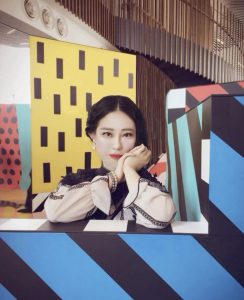
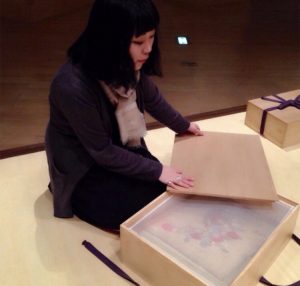
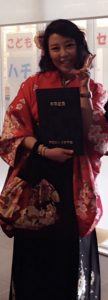
Kim Glassman 21:26
Well, thank you so much – honestly the answers that you’ve curated here are really inspiring. And Seeun I’ve only seen your work so far online, because we have obviously the images of what we are going to install at The North Wall, but they look absolutely gorgeous. And they have sucha story behind them, which is honestly, what I, as an art historian, what I love – when you have something beautiful that draws you in, but then has a message that they sneak into you so that you get more when you look at them. We’re just so excited to have your work at The North Wall and I cannot wait to have the art just in the space.
[Outro Music: Snappy, an instrumental and upbeat jazz track plays underneath the closing dialogue. It features clicks and a bass guitar.]
Seeun Kim 22:13
Thank you so much, I’m really honoured to be invited to this worthwhile time.
Kim Glassman 22:19
The OXFORD PROJECT will be showing at The North Wall from the 28th May til the 12th June 2021.
Amelia Thornber 22:25
If you want to hear more don’t forget to subscribe.
Kim Glassman 22:28
For more info and all of our upcoming live and digital events, head to our website www.thenorthwall.com.
Amelia Thornber 22:34
You can also follow @ the north wall on all social media channels.
Kim Glassman 22:38
Stay connected and until next time!


